An Assessment of Bio-Physical and Social Drivers of River Vulnerability and Risks
Abstract
1. Introduction
2. Material and Methods
2.1. Study Areas
2.2. Methodology
2.2.1. Bio-Physical Vulnerability Assessment
2.2.2. Social Vulnerability Assessment
Public Perception Survey
2.2.3. The Study Limitations
3. Results
3.1. Bio-Physical Vulnerability Assessment—Transparency and Total Dissolved Solids
3.2. Bio-Physical Vulnerability Assessment—Chemical Tests
3.3. Bio-Physical Vulnerability Assessment—Biological Elements
4. Social Vulnerability Assessment
4.1. Survey Results
- i.
- Rishikesh;
- ii.
- Haridwar;
- iii.
- Kanpur;
- iv.
- Varanasi.
4.2. Pollution of the Ganges in Rishikesh
4.3. Pollution of the Ganges in Haridwar
4.4. Pollution of the Ganges in Kanpur
4.5. Pollution of the Ganges in Varanasi
5. Discussion
5.1. Overview of Bio-Physical Vulnerability of the River Ganges
5.2. Social Perception: Combined Data Synthesis
5.3. Comparison of Physical and Social Vulnerability Results
6. Recommendations
- Submission of a Policy Briefing (workbook) with the purpose of educating and influencing national and regional policy and decision makers;
- Work with communities to educate and raise awareness of behaviors and practices that will improve water quality in the river, such as the promotion of good sanitation;
- Work with and encourage local communities to become citizen scientists, involved in the River Ganges cleaning program;
- Set achievement targets for cultural programs over specific time periods (e.g., 5–10 years);
- Install signboards near Ganga ghats to display live water quality information;
- Implement a ban on the release of industrial effluents directly into the river;
- Arrange a green corridor along the riverfront;
- Enforce significant penalties for breaking rules and regulations and improve enforcement;
- Implement a water quality monitoring program;
- Promote the Namami Gange program through various channels, including public, private, and NGOs;
- Regularly conduct camps and training programs on water pollution and river water quality;
- Provide more detailed information on culture and water quality to national and international tourists;
- Regulate and strictly prohibit river water contamination at all levels;
- Promote sustainable sea waste disposal facilitates at village levels;
- Invest in operation research to understand river water pollution and water quality management.
7. Scope for Future Research
8. Conclusions
Author Contributions
Funding
Institutional Review Board Statement
Data Availability Statement
Conflicts of Interest
References
- Paul, D. Research on heavy metal pollution of river Ganga: A review. Ann. Agrar. Sci. 2017, 15, 278–286. [Google Scholar] [CrossRef]
- Kumar, N. 3Ps (population, poverty and pollution) and the pious poor Ganga. In Our National River Ganga: Lifeline Millions; Springer: Berlin/Heidelberg, Germany, 2014; pp. 307–319. [Google Scholar]
- Wang, J.; Liu, X.; Lu, J. Urban river pollution control and remediation. Procedia Environ. Sci. 2012, 13, 1856–1862. [Google Scholar] [CrossRef]
- Agarwal, A.K.; Rajwar, G.S. Physico-chemical and microbiological study of Tehri dam reservoir, Garhwal Himalaya, India. J. Am. Sci. 2010, 6, 65–71. [Google Scholar]
- Gaur, S. An updated review on quantitative and qualitative analysis of water pollution in west flowing Tapi River of Gujarat, India. In Environmental Pollution: Select Proceedings of ICWEES-2016; Springer: Berlin/Heidelberg, Germany, 2018; pp. 525–547. [Google Scholar]
- Mariya, A.; Kumar, C.; Masood, M.; Kumar, N. The pristine nature of river Ganges: Its qualitative deterioration and suggestive restoration strategies. Environ. Monit. Assess. 2019, 191, 542. [Google Scholar] [CrossRef]
- Dutta, A.; Karmakar, S.; Das, S.; Banerjee, M.; Ray, R.; Hasher, F.F.B.; Mishra, V.N.; Zhran, M. Modeling the River Health and Environmental Scenario of the Decaying Saraswati River, West Bengal, India, Using Advanced Remote Sensing and GIS. Water 2025, 17, 965. [Google Scholar] [CrossRef]
- Singh, N.; Tung, S. Assessment of Water Quality of Gomti River at Lucknow. Air Soil Water Res. 2025, 18, 11786221251328589. [Google Scholar] [CrossRef]
- Sanad, H.; Moussadek, R.; Mouhir, L.; Lhaj, M.O.; Dakak, H.; Zouahri, A. Geospatial analysis of trace metal pollution and ecological risks in river sediments from agrochemical sources in Morocco’s Sebou basin. Sci. Rep. 2025, 15, 16701. [Google Scholar] [CrossRef]
- Best, J. Anthropogenic stresses on the world’s big rivers. Nat. Geosci. 2019, 12, 7–21. [Google Scholar] [CrossRef]
- Xu, L.; Mao, Q.; Li, C.; Tu, B.; Li, X. Natural factors outweigh anthropogenic impact on aquatic phoD-harboring communities along Yangtze River basin. Ecol. Indic. 2025, 170, 112995. [Google Scholar] [CrossRef]
- Assie, A.F.; Arimoro, F.O.; Nantege, D.; Ndatimana, G.; Action, S.; Keke, U.N.; Ayanwale, A.V.; Edia, E.O. Exploring macroinvertebrate traits along anthropogenic disturbed gradient in West African Savanna River systems: A case study of Niger state, North central region of Nigeria. Biologia 2025, 80, 853–875. [Google Scholar] [CrossRef]
- Liu, L.; Liu, D.; Johnson, D.M.; Yi, Z.; Huang, Y. Effects of vertical mixing on phytoplankton blooms in Xiangxi Bay of Three Gorges Reservoir: Implications for management. Water Res. 2012, 46, 2121–2130. [Google Scholar] [CrossRef] [PubMed]
- Gao, Q.; Li, Y.; Cheng, Q.; Yu, M.; Hu, B.; Wang, Z.; Yu, Z. Analysis and assessment of the nutrients, biochemical indexes and heavy metals in the Three Gorges Reservoir, China, from 2008 to 2013. Water Res. 2016, 92, 262–274. [Google Scholar] [CrossRef] [PubMed]
- Ahmed, A.S.; Hossain, M.B.; Babu, S.O.F.; Rahman, M.M.; Sarker, M.S.I. Human health risk assessment of heavy metals in water from the subtropical river, Gomti, Bangladesh. Environ. Nanotechnol. Monit. Manag. 2021, 15, 100416. [Google Scholar]
- Lin, L.; Yang, H.; Xu, X. Effects of water pollution on human health and disease heterogeneity: A review. Front. Environ. Sci. 2022, 10, 880246. [Google Scholar] [CrossRef]
- Wasewar, K.L.; Singh, S.; Kansal, S.K. Process intensification of treatment of inorganic water pollutants. In Inorganic Pollutants in Water; Elsevier: Amsterdam, The Netherlands, 2020; pp. 245–271. [Google Scholar]
- Liosis, C.; Papadopoulou, A.; Karvelas, E.; Karakasidis, T.E.; Sarris, I.E. Heavy metal adsorption using magnetic nanoparticles for water purification: A critical review. Materials 2021, 14, 7500. [Google Scholar] [CrossRef]
- Kumar, A.; Sidharth, S.; Kandasubramanian, B. A review on algal biosorbents for heavy metal remediation with different adsorption isotherm models. Environ. Sci. Pollut. Res. 2023, 30, 39474–39493. [Google Scholar] [CrossRef]
- Dutta, V.; Dubey, D.; Kumar, S. Cleaning the River Ganga: Impact of lockdown on water quality and future implications on river rejuvenation strategies. Sci. Total Environ. 2020, 743, 140756. [Google Scholar] [CrossRef]
- Sarkar, S.K.; Saha, M.; Takada, H.; Bhattacharya, A.; Mishra, P.; Bhattacharya, B. Water quality management in the lower stretch of the river Ganges, east coast of India: An approach through environmental education. J. Clean. Prod. 2007, 15, 1559–1567. [Google Scholar] [CrossRef]
- Das, P.; Tamminga, K.R. The Ganges and the GAP: An assessment of efforts to clean a sacred river. Sustainability 2012, 4, 1647–1668. [Google Scholar] [CrossRef]
- Dwivedi, S.; Mishra, S.; Tripathi, R.D. Ganga water pollution: A potential health threat to inhabitants of Ganga basin. Environ. Int. 2018, 117, 327–338. [Google Scholar] [CrossRef]
- Markandya, A.; Murty, M.N. Cleaning-Up the Ganges: A Cost-Benefit Analysis of the Ganga Action Plan; Oxford University Press: New York, NY, USA, 2000. [Google Scholar]
- Tripathi, B.D. Ganges superbugs are threat to world health, in Future OF Water 2016, RACONTEUR. Available online: https://www.raconteur.net/future-of-water-2016/ganges-superbugs-are-threat-to-world-health (accessed on 24 June 2025).
- Roy, M.; Shamim, F. Research on the impact of industrial pollution on River Ganga: A Review. Int. J. Prev. Control Ind. Pollut. 2020, 6, 43–51. [Google Scholar]
- Haque, M.M.; Niloy, N.M.; Nayna, O.K.; Fatema, K.J.; Quraishi, S.B.; Park, J.-H.; Kim, K.-W.; Tareq, S.M. Variability of water quality and metal pollution index in the Ganges River, Bangladesh. Environ. Sci. Pollut. Res. 2020, 27, 42582–42599. [Google Scholar] [CrossRef] [PubMed]
- Manganye, B. Evaluation of Water Quality in Surface Water Bodies near Industrial Areas in the East Rand, Gauteng, South Africa; University of Johannesburg: Johannesburg, South Africa, 2020. [Google Scholar]
- Aggarwal, M.; Anbukumar, S.; Vijaya Kumar, T. Assessment of pollution risks posed by trace elements in the riverbed sediment of the Ganges River in Eastern Uttar Pradesh, India. Water Supply 2025, 25, 628–646. [Google Scholar] [CrossRef]
- Sulaiman, M.A.; Kumari, A. Unveiling the rising threat of cadmium pollution and alarming health risks associated with the consumption of 15 commercially important fish species in the middle stretch of River Ganga, at Patna, India. Biol. Trace Elem. Res. 2025, 203, 422–441. [Google Scholar] [CrossRef]
- De, D. Public perception regarding pollution of the river Ganga: Case study at Dakhineswar. Int. J. Res. Soc. Sci. 2018, 8, 449–463. [Google Scholar]
- Basu Roy, S. Ganga Action Plan (GAP): The Challenge of ‘Regulatory Quality’. 2017. Available online: https://mpra.ub.uni-muenchen.de/81148/1/MPRA_paper_81148.pdf (accessed on 24 June 2025).
- Tare, V.; Bose, P.; Gupta, S.K. Suggestions for a modified approach towards implementation and assessment of Ganga action plan and other similar river action plans in India. Water Qual. Res. J. 2003, 38, 607–626. [Google Scholar] [CrossRef]
- Mathur, A. Namami Gange Scheme—A Success or mere propaganda? GLS Law J. 2020, 2, 54–64. [Google Scholar] [CrossRef]
- Balkrishna, A.; Singh, S.K.; Pathak, R.; Arya, V. Namami Gange: An Opinion based framework and possible resolution. Authorea 2022. [Google Scholar] [CrossRef]
- Sharma, S.; Agrawal, M. The river Ganga and its pollution-tourists’ perception visiting Ghats of Varanasi. Turizam 2021, 25, 55–71. [Google Scholar] [CrossRef]
- Wohl, E. Connectivity in rivers. Prog. Phys. Geogr. 2017, 41, 345–362. [Google Scholar] [CrossRef]
- Blaikie, P.; Cannon, T.; Davis, I.; Wisner, B. At Risk: Natural Hazards, People’s Vulnerability and Disasters; Routledge: Milton Park, UK, 2014. [Google Scholar]
- Chen, W.; Cutter, S.L.; Emrich, C.T.; Shi, P. Measuring social vulnerability to natural hazards in the Yangtze River Delta region, China. Int. J. Disaster Risk Sci. 2013, 4, 169–181. [Google Scholar] [CrossRef]
- Cutter, S.L.; Boruff, B.J.; Shirley, W.L. Social vulnerability to environmental hazards. Soc. Sci. Q. 2003, 84, 242–261. [Google Scholar] [CrossRef]
- Li, Y.; Zhou, Q.; Ren, B.; Luo, J.; Yuan, J.; Ding, X.; Bian, H.; Yao, X. Trends and health risks of dissolved heavy metal pollution in global river and lake water from 1970 to 2017. In Reviews of Environmental Contamination and Toxicology; Springer: Berlin/Heidelberg, Germany, 2020; Volume 251, pp. 1–24. [Google Scholar]
- Meybeck, M.; Helmer, R. The quality of rivers: From pristine stage to global pollution. Palaeogeogr. Palaeoclimatol. Palaeoecol. 1989, 75, 283–309. [Google Scholar] [CrossRef]
- Niu, Y.; Chen, F.; Li, Y.; Ren, B. Trends and sources of heavy metal pollution in global river and lake sediments from 1970 to 2018. In Reviews of Environmental Contamination and Toxicology; Springer: Berlin/Heidelberg, Germany,, 2021; Volume 257, pp. 1–35. [Google Scholar]
- Munafo, M.; Cecchi, G.; Baiocco, F.; Mancini, L. River pollution from non-point sources: A new simplified method of assessment. J. Environ. Manag. 2005, 77, 93–98. [Google Scholar] [CrossRef]
- He, B.; Kanae, S.; Oki, T.; Hirabayashi, Y.; Yamashiki, Y.; Takara, K. Assessment of global nitrogen pollution in rivers using an integrated biogeochemical modeling framework. Water Res. 2011, 45, 2573–2586. [Google Scholar] [CrossRef]
- Beusen, A.; Dekkers, A.; Bouwman, A.; Ludwig, W.; Harrison, J. Estimation of global river transport of sediments and associated particulate C, N, and P. Glob. Biogeochem. Cycles 2005, 19, GB4S05. [Google Scholar] [CrossRef]
- van Vliet, M.T.; Franssen, W.H.; Yearsley, J.R.; Ludwig, F.; Haddeland, I.; Lettenmaier, D.P.; Kabat, P. Global river discharge and water temperature under climate change. Glob. Environ. Change 2013, 23, 450–464. [Google Scholar] [CrossRef]
- Mani, T.; Hauk, A.; Walter, U.; Burkhardt-Holm, P. Microplastics profile along the Rhine River. Sci. Rep. 2015, 5, 17988. [Google Scholar] [CrossRef]
- Xie, Q.; Ren, B. Pollution and risk assessment of heavy metals in rivers in the antimony capital of Xikuangshan. Sci. Rep. 2022, 12, 14393. [Google Scholar] [CrossRef]
- Mateo-Sagasta, J.; Zadeh, S.M.; Turral, H.; Burke, J. Water Pollution from Agriculture: A Global Review. Executive Summary; FAO: Rome, Italy, 2017. [Google Scholar]
- Nriagu, J.O. Global metal pollution: Poisoning the biosphere? Environ. Sci. Policy Sustain. Dev. 1990, 32, 7–33. [Google Scholar] [CrossRef]
- Chaudhary, M.; Walker, T.R. River Ganga pollution: Causes and failed management plans (correspondence on Dwivedi et al. 2018. Ganga water pollution: A potential health threat to inhabitants of Ganga basin. Environment International 117, 327–338). Environ. Int. 2019, 126, 202–206. [Google Scholar] [CrossRef] [PubMed]
- Matta, G. A study on physico-chemical Characteristics to assess the pollution status of river Ganga in Uttarakhand. J. Chem. Pharm. Sci. 2014, 7, 210–217. [Google Scholar]
- Chaudhary, M.; Mishra, S.; Kumar, A. Estimation of water pollution and probability of health risk due to imbalanced nutrients in River Ganga, India. Int. J. River Basin Manag. 2017, 15, 53–60. [Google Scholar] [CrossRef]
- Rai, P.; Mishra, A.; Tripathi, B. Heavy metal and microbial pollution of the River Ganga: A case study of water quality at Varanasi. Aquat. Ecosyst. Health Manag. 2010, 13, 352–361. [Google Scholar] [CrossRef]
- Khanna, D.; Bhutiani, R.; Kulkarni, D.B. A study on pollution status and its impact on water quality of River Ganga at Haridwar. Environ. Conserv. J. 2011, 12, 9–15. [Google Scholar] [CrossRef]
- Government of India. Census Data—Districts of Uttar Pradesh. 2011. Available online: https://www.census2011.co.in/census/state/districtlist/uttar+pradesh.html (accessed on 3 March 2022).
- Government of India. Census Data -Districts of Uttarakhand. 2011. 2011. Available online: https://www.census2011.co.in/census/state/districtlist/uttarakhand.html (accessed on 3 March 2022).
- Government of India. Census Data—2011-Rishikesh Population Census 2011–2024. 2011. Available online: https://www.census2011.co.in/census/metropolitan/30-rishikesh.html (accessed on 3 March 2022).
- Government of India. Census Data—2011-Haridwar District—Population 2011–2024. 2011. Available online: https://www.census2011.co.in/census/district/586-haridwar.html (accessed on 3 February 2023).
- Government of India. Census Data—2011-Districts of Uttar Pradesh. 2011. Available online: https://www.census2011.co.in/census/district/535-kanpur-nagar.html (accessed on 2 January 2023).
- Thareja, S.; Choudhury, S.; Trivedi, P. Assessment of water quality of Ganga River in Kanpur by using principal components analysis. Adv. Appl. Sci. Res. 2011, 2, 84–91. [Google Scholar]
- Bhatnagar, S.; Sharma, A.; Kumar, A. Impact assessment of ground water quality at Varanasi, Uttar Pradesh. Int. J. Environ. Rehabil. Conserv. 2021, 12, 1–9. [Google Scholar]
- Singh, Y.; Bharteey, P.K.; Singh, K.; Borah, S.R.; Kumar, A.; Pal, S.; Barla, F.X. Assessment of Water Quality in Ganga River Ghats of Varanasi District, Uttar Pradesh, India. Int. J. Environ. Clim. Change 2023, 13, 231–239. [Google Scholar] [CrossRef]
- Census. Varanasi Population. 2024. Available online: https://indiagraphy.com/uttar-pradesh/varanasi.html (accessed on 15 April 2023).
- Rai, P.K.; Mohan, K. Remote sensing data & GIS for flood risk zonation mapping in Varanasi District, India. Forum Geogr. 2014, 13, 25–33. [Google Scholar]
- World Health Organisation (WHO). 9 out of 10 People Worldwide Breathe Polluted Air, But More Countries Are Taking Action. 2018. Available online: https://www.who.int/news/item/02-05-2018-9-out-of-10-people-worldwide-breathe-polluted-air-but-more-countries-are-taking-action (accessed on 16 April 2023).
- Basak, S.; Sarkar, A.; Ghosh, R.; Chaudhuri, A. Ghats of Varanasi—An emerging centre of pollution. IOSR J. Humanit. Soc. Sci. 2015, 20, 19–24. [Google Scholar]
- Rana, P.S. Pilgrimage Tourism: A Study of Varanasi; SRME Publishers: Sagar, MP, India, 2014. [Google Scholar]
- Singh, R.P. Varanasi, the Heritage Capital of India: Valuing the Sacredscapes. In Proceedings of the International Seminar on Indian Art Heritage in a Changing World: Challenges and Prospects, Varanasi, India, 27 February–1 March 2017. [Google Scholar]
- Central Pollution Control Board. India. Guidelines for Water Quality Monitoring. 2024. Available online: https://cpcb.nic.in/openpdffile.php?id=UmVwb3J0RmlsZXMvTmV3SXRlbV8xMTZfR3VpZGVsaW5lc29mIHdhdGVycXVhbGl0eW1vbml0b3JpbmdfMzEuMDcuMDgucGRm (accessed on 11 January 2024).
- IS 2296-1982; Indian Standard for Surface Water Prescribed by Bureau of Indian Standards. Central Water Commission: New Delhi, India, 2024.
- Adjovu, G.E.; Stephen, H.; James, D.; Ahmad, S. Measurement of Total Dissolved Solids and Total Suspended Solids in Water Systems: A Review of the Issues, Conventional, and Remote Sensing Techniques. Remote Sens. 2023, 15, 3534. [Google Scholar] [CrossRef]
- Hannah, D.M.; Abbott, B.W.; Khamis, K.; Kelleher, C.; Lynch, I.; Krause, S.; Ward, A.S. Illuminating the ‘invisible water crisis’ to address global water pollution challenges. Hydrol. Process. 2022, 36. [Google Scholar] [CrossRef]
- Kumar, D. River Ganges–Historical, cultural and socioeconomic attributes. Aquat. Ecosyst. Health Manag. 2017, 20, 8–20. [Google Scholar] [CrossRef]
- Leaf-Nosed Bat. Encyclopædia Britannica. 2009. Available online: https://www.britannica.com/animal/leaf-nosed-bat (accessed on 11 January 2024).
- Tripathi, B.; Tripathi, S. Issues and challenges of river Ganga. In Our National River Ganga: Lifeline of Millions; Springer: Berlin/Heidelberg, Germany, 2014; pp. 211–221. [Google Scholar]
- Singh, S.; Rai, J. Pollution studies on river Ganga in Allahabad district. Pollut. Res. 2003, 22, 469–472. [Google Scholar]
- Ramesh, P. Sacred Yet Polluted: Ganges Pollution During Mahakumbh 2025. Indian J. Integr. Res. Law 2025, 5, 13. [Google Scholar]
- Mishra, A. Assessment of water quality using principal component analysis: A case study of the river Ganges. J. Water Chem. Technol. 2010, 32, 227–234. [Google Scholar] [CrossRef]
- Vortmann, M.; Balsari, S.; Holman, S.R.; Greenough, P.G. Water, sanitation, and hygiene at the world’s largest mass gathering. Curr. Infect. Dis. Rep. 2015, 17, 5. [Google Scholar] [CrossRef]
- Khan, M.H.R.B.; Ahsan, A.; Imteaz, M.; Shafiquzzaman, M.; Al-Ansari, N. Evaluation of the surface water quality using global water quality index (WQI) models: Perspective of river water pollution. Sci. Rep. 2023, 13, 20454. [Google Scholar] [CrossRef]
- Wang, M.; Bodirsky, B.L.; Rijneveld, R.; Beier, F.; Bak, M.P.; Batool, M.; Droppers, B.; Popp, A.; van Vliet, M.T.; Strokal, M. A triple increase in global river basins with water scarcity due to future pollution. Nat. Commun. 2024, 15, 880. [Google Scholar] [CrossRef]
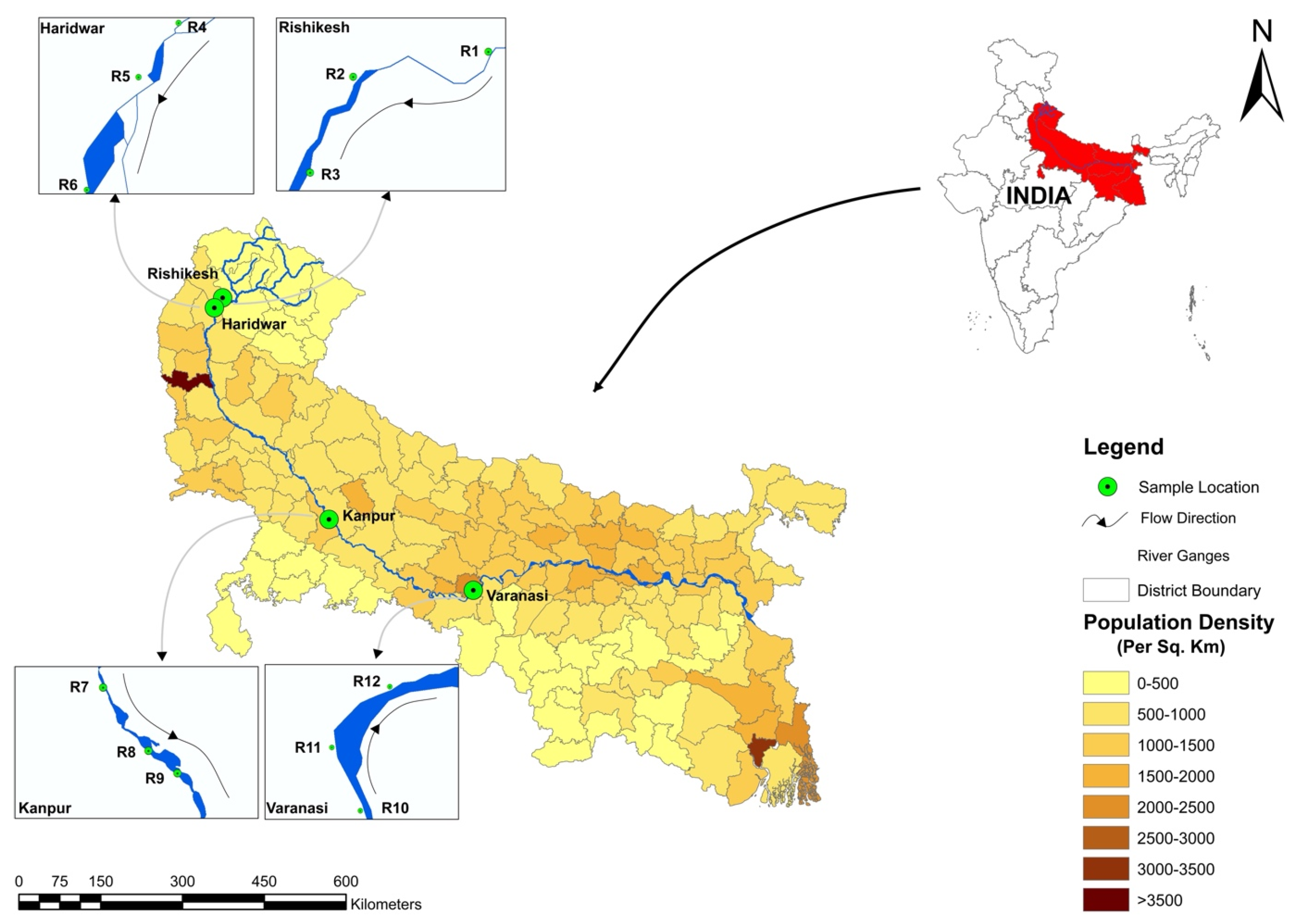

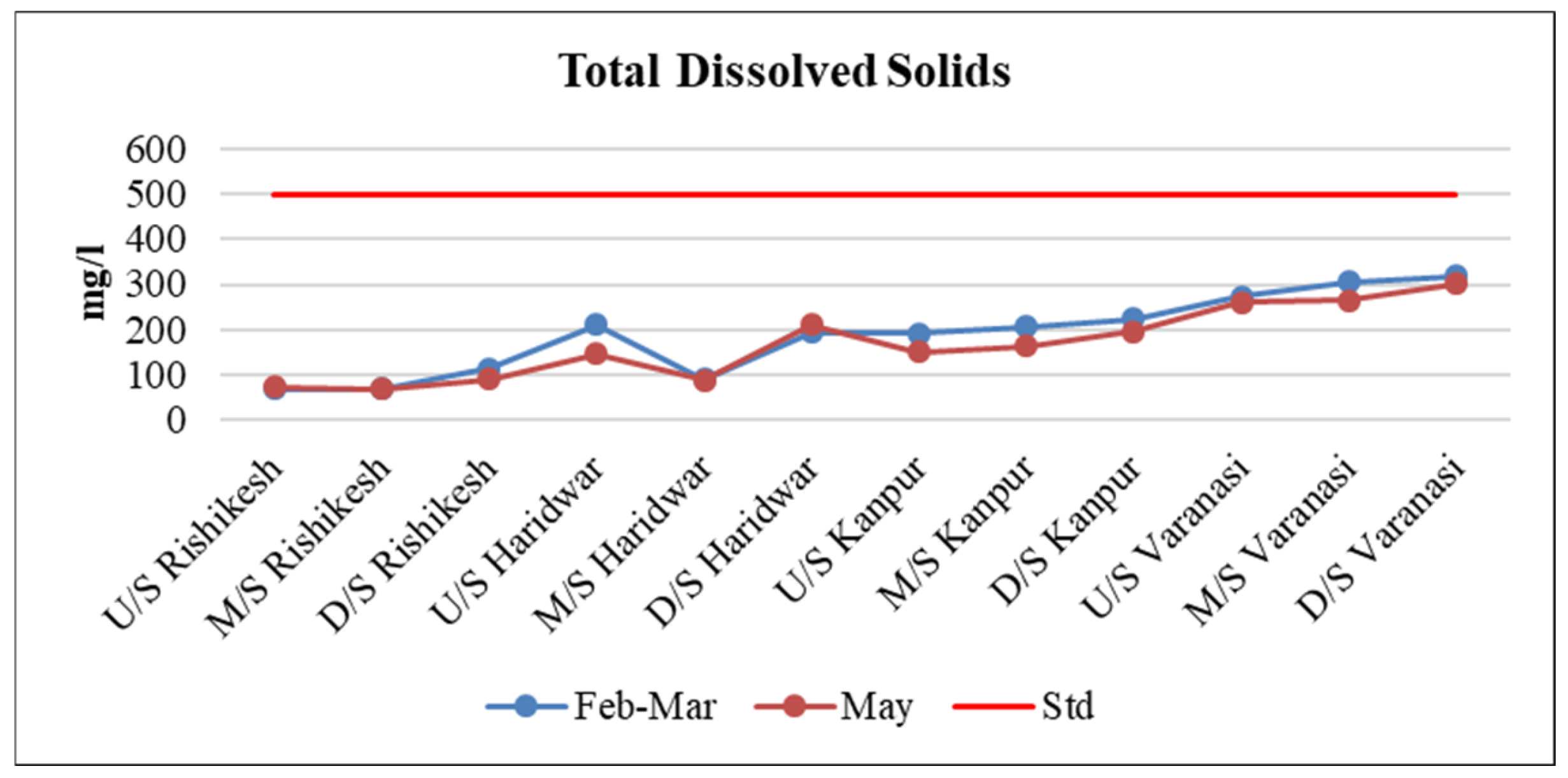
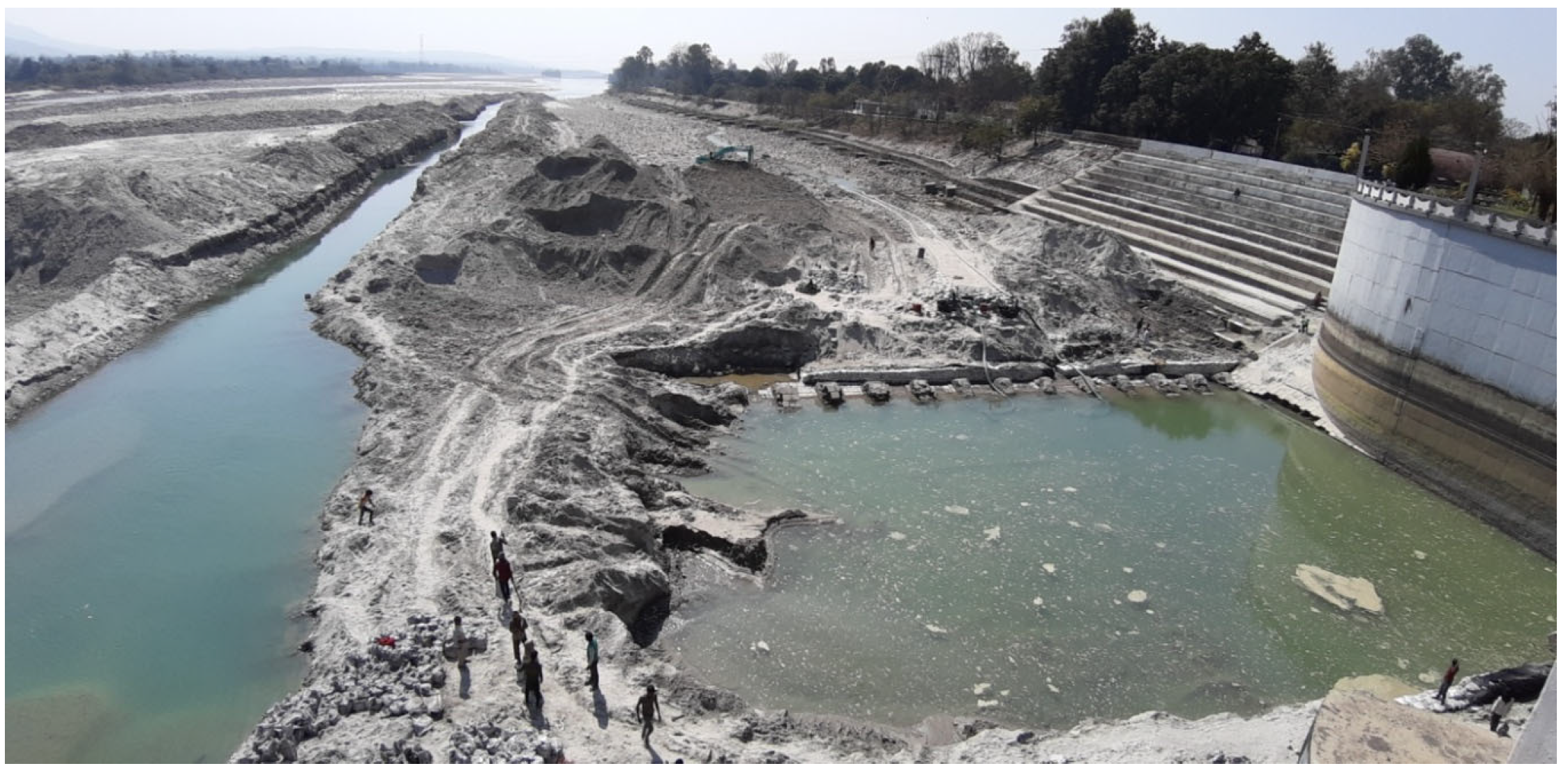


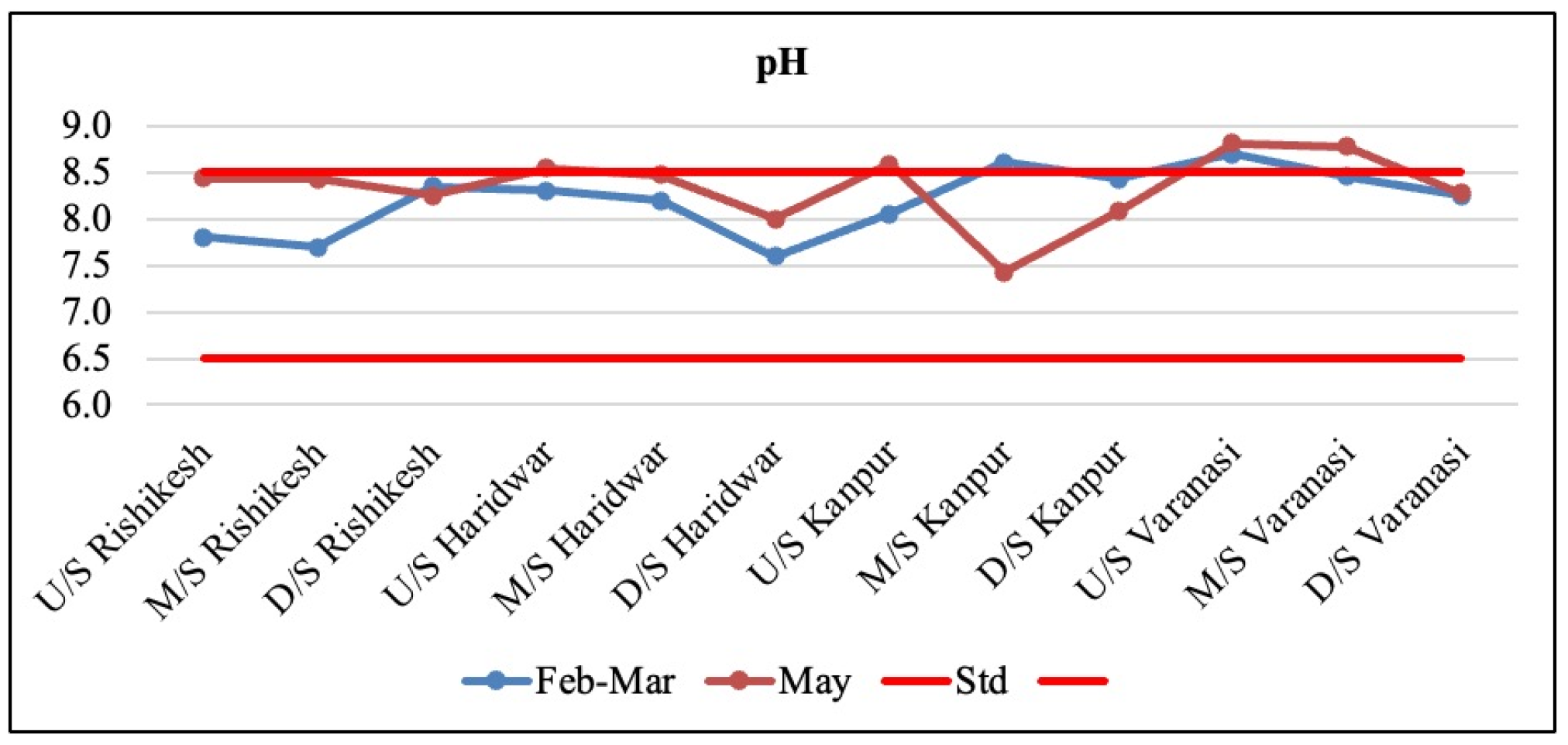
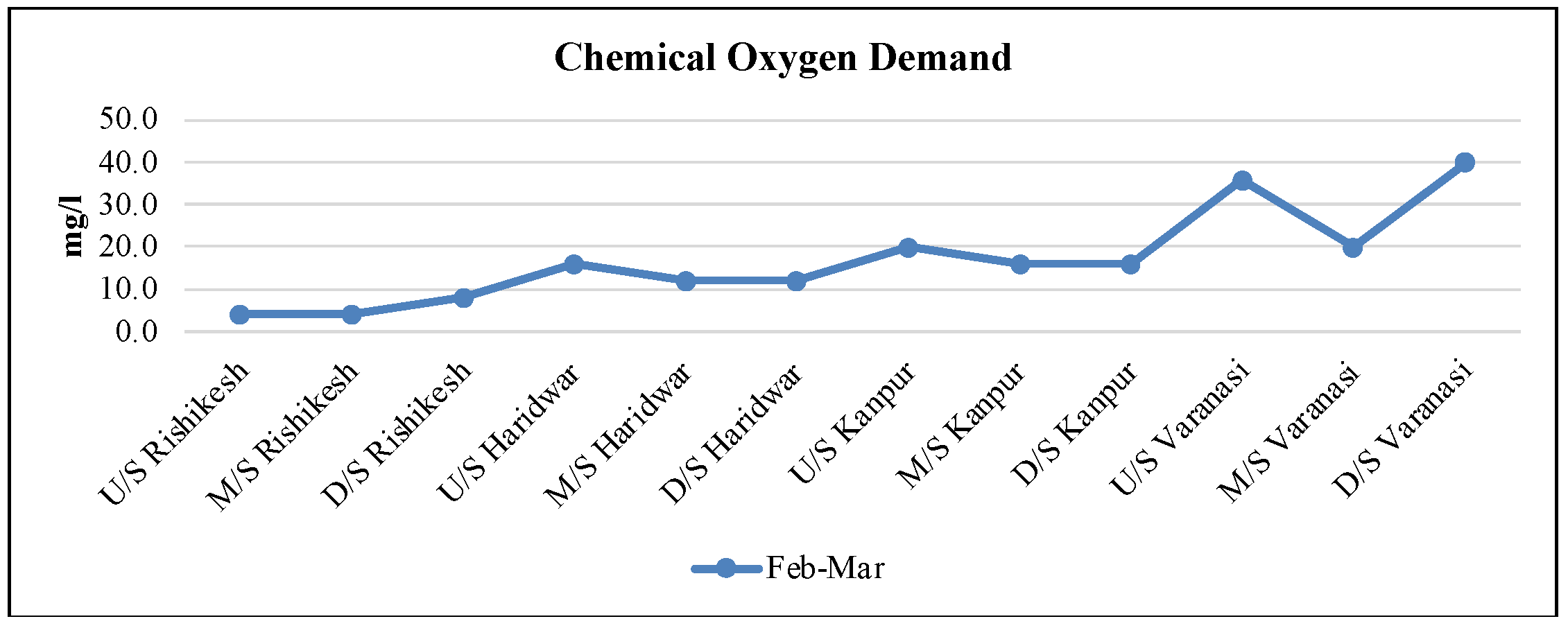
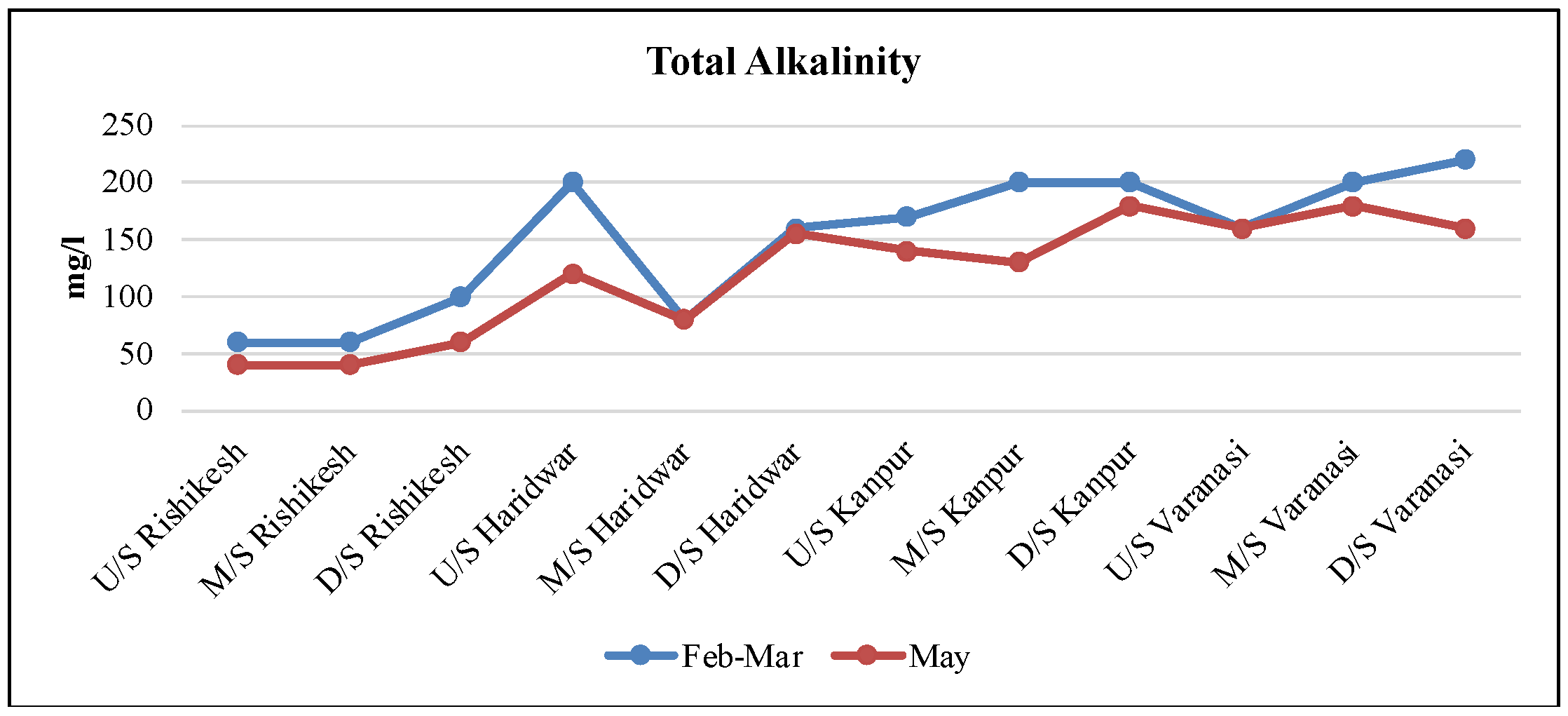

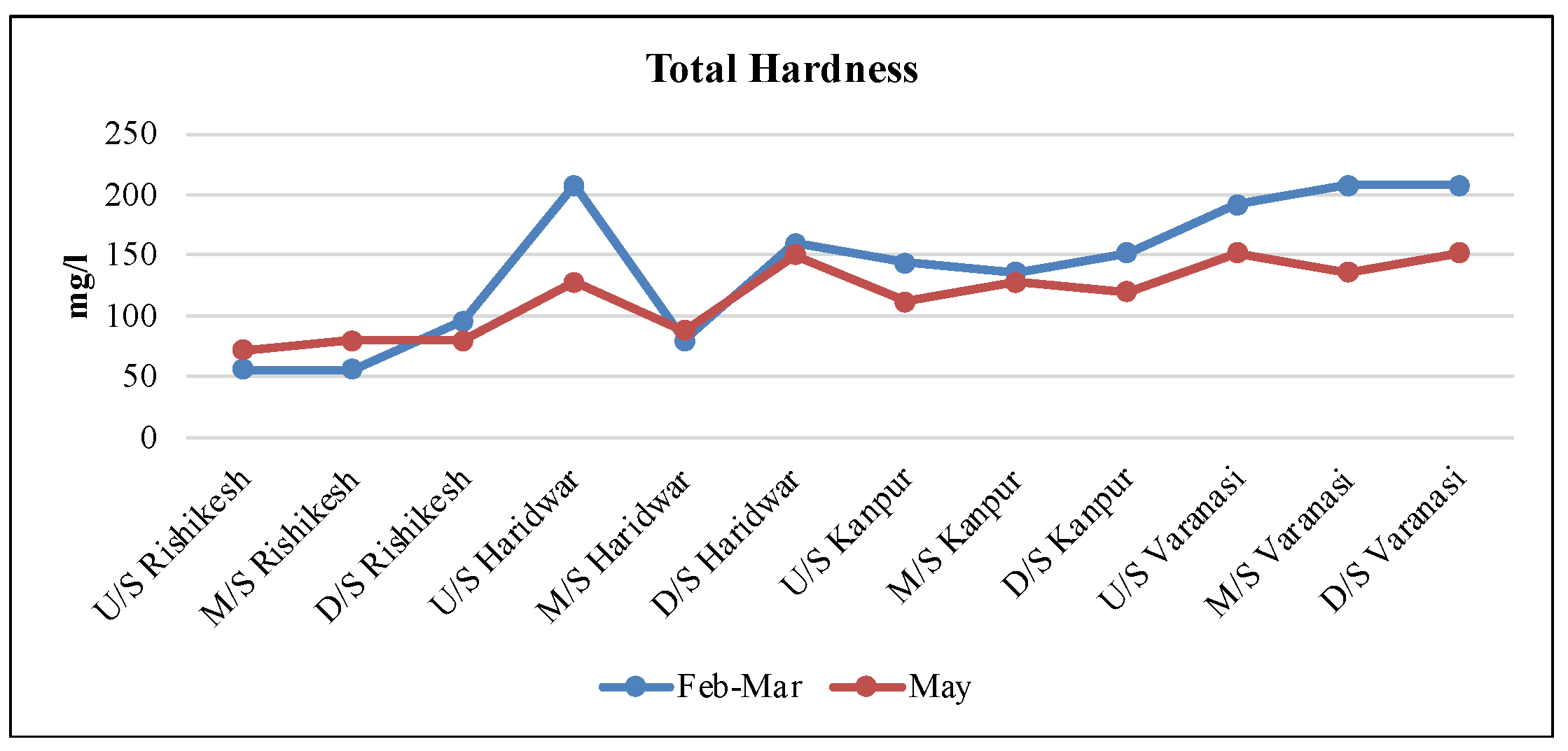
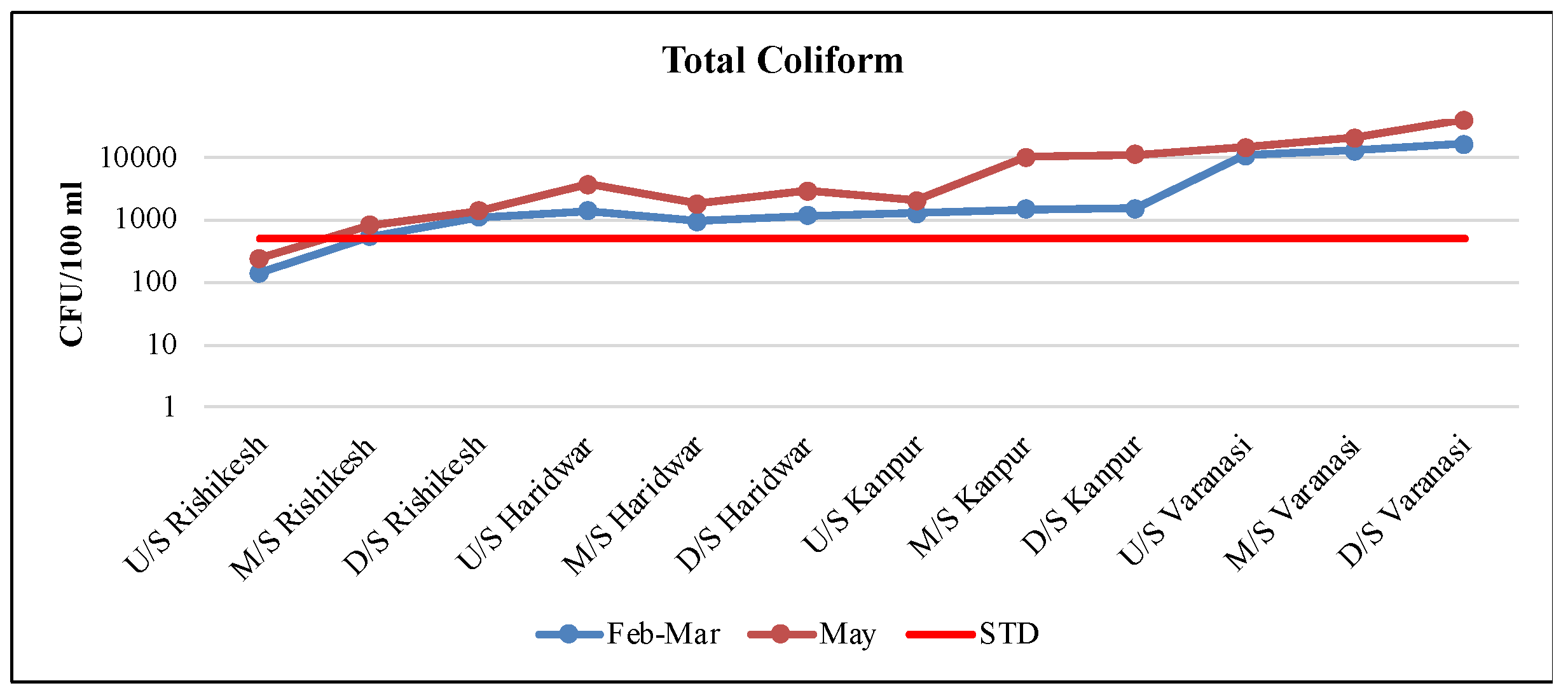
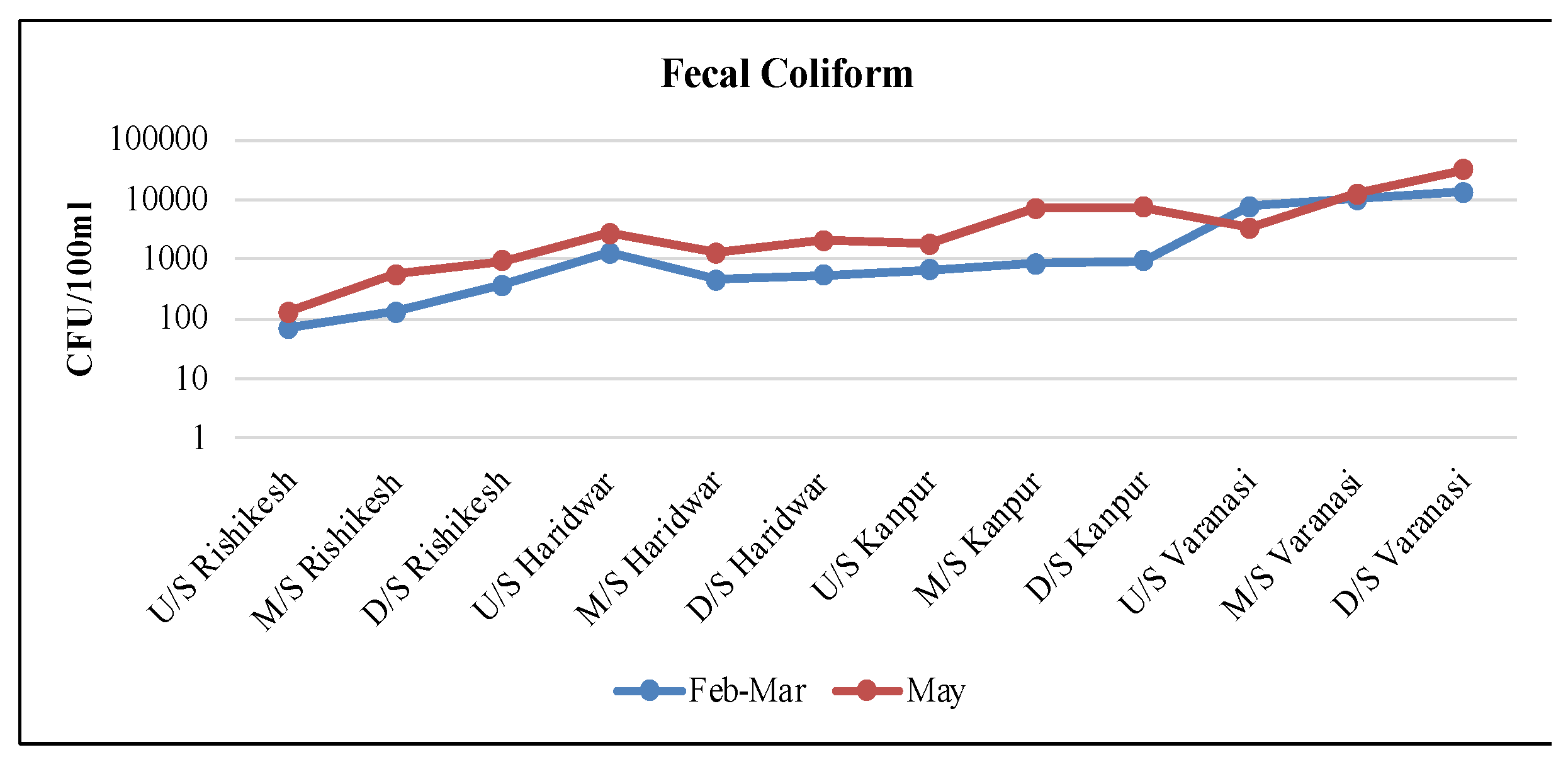
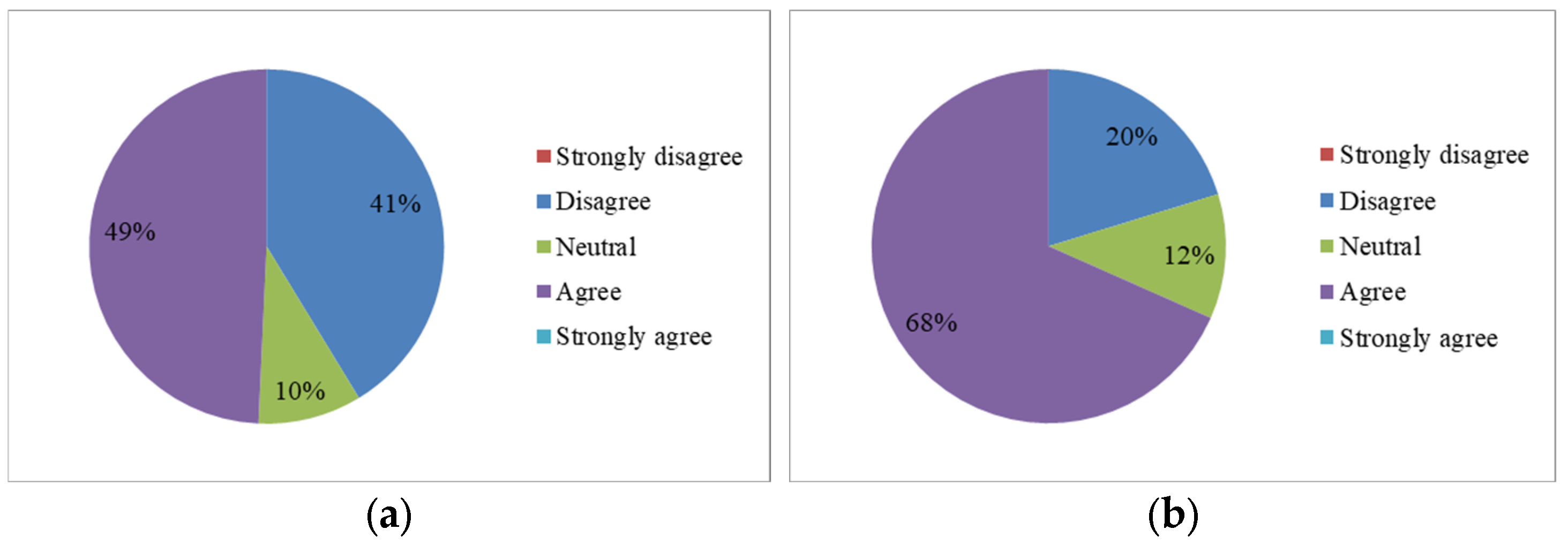



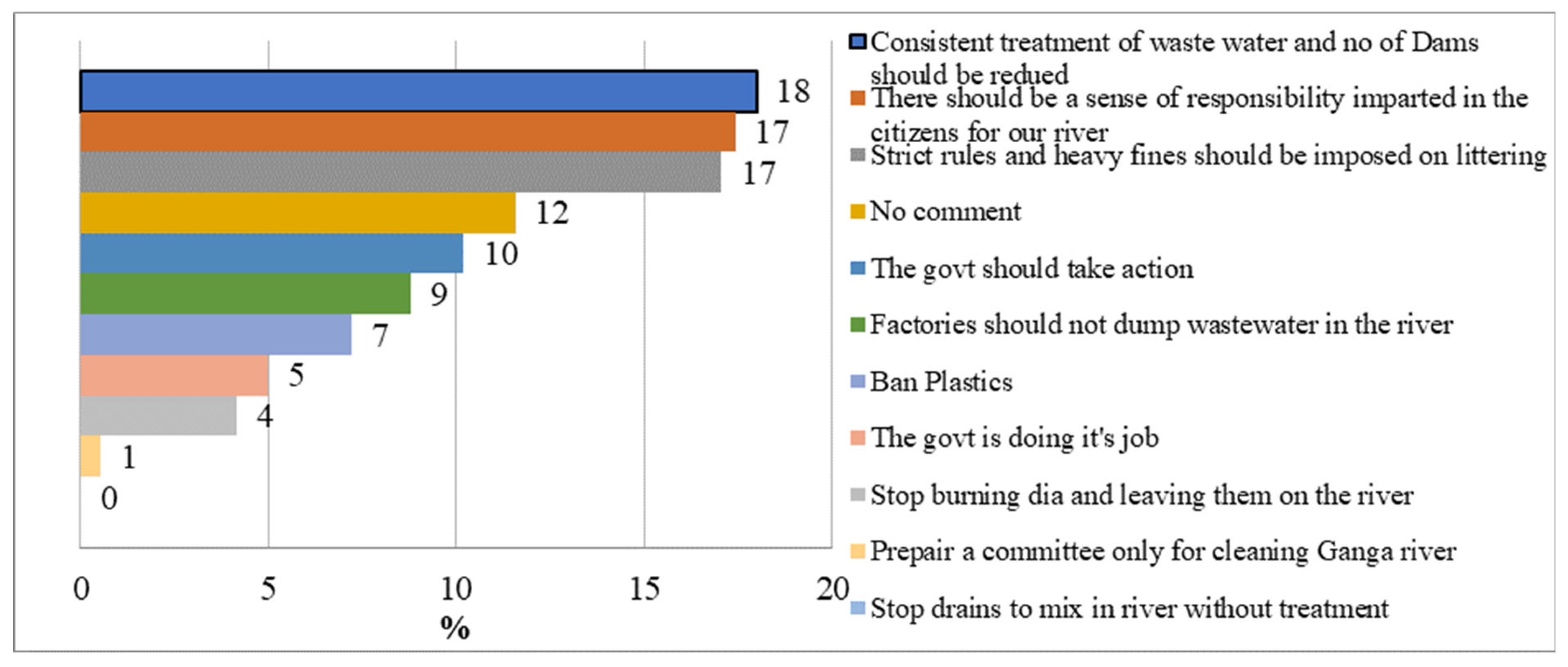


| Sample Code | Location Name | Latitude | Longitude | Sampling Date | |
|---|---|---|---|---|---|
| Phase 1 | Phase 2 | ||||
| R1 | U/S Rishikesh | 30°08′06″ N | 78°23′27″ E | 22 February 2023 | 26 May 2023 |
| R2 | M/S Rishikesh | 30°07′12″ N | 78°18′30″ E | 22 February 2023 | 26 May 2023 |
| R3 | D/S Rishikesh | 30°04′06″ N | 78°17′00″ E | 22 February 2023 | 26 May 2023 |
| R4 | U/S Haridwar | 29°59′08″ N | 78°11′43″ E | 22 February 2023 | 27 May 2023 |
| R5 | M/S Haridwar | 29°57′20″ N | 78°10′16″ E | 22 February 2023 | 27 May 2023 |
| R6 | D/S Haridwar | 29°53′37″ N | 78°08′26″ E | 22 February 2023 | 27 May 2023 |
| R7 | U/S Kanpur | 26°35′44.00″ N | 80°16′43.79″ E | 7 March 2023 | 9 May 2023 |
| R8 | M/S Kanpur | 26°26′40.8″ N | 80°24′30.0″ E | 7 March 2023 | 9 May 2023 |
| R9 | D/S Kanpur | 26°22′40.8″ N | 80°29′26.8″ E | 7 March 2023 | 9 May 2023 |
| R10 | U/S Varanasi | 25°15′14″ N | 83°01′33″ E | 9 February 2023 | 28 May 2023 |
| R11 | M/S Varanasi | 25°17′35″ N | 83°00′26″ E | 9 February 2023 | 28 May 2023 |
| R12 | D/S Varanasi | 25°19′48″ N | 83°02′49″ E | 9 February 2023 | 28 May 2023 |
| Physical Tests | Chemical Tests | Biological Testes |
|---|---|---|
| 1. Transparency | 1. DO (dissolved oxygen) | 1. Total coliform |
| 2. Total dissolved solids | 2. pH | 2. Fecal coliform |
| 3. COD (chemical oxygen demand) | ||
| 4. Alkalinity | ||
| 4. BOD (biological oxygen demand) | ||
| 5. Alkalinity | ||
| 6. TO (total hardness) | ||
| 7. Others: chloride, fluoride, nitrogen, sodium, ammoniacal nitrogen |
| pH | TDS (mg/L) | DO (mg/L) | BOD (mg/L) | Transparency (m) | Alkalinity (mg/L) | Total Hardness (mg/L) | Ca++ (mg/L) | Mg++ (mg/L) | |
|---|---|---|---|---|---|---|---|---|---|
| Rishikesh | 8.2 ± 0.3 | 80 ± 18.2 | 8.3 ± 1.3 | 1.1 ± 0.6 | -- | 60 ± 22 | 73 ± 16 | 20 ± 6 | 6 ± 3 |
| Haridwar | 8.2 ± 0.3 | 156 ± 57.6 | 8.7 ± 1.3 | 2.0 ± 0.9 | -- | 133 ± 48 | 136 ± 48 | 35 ± 12 | 12 ± 4 |
| Kanpur | 8.2 ± 0.4 | 189 ± 27.1 | 7.6 ± 0.6 | 6.6 ± 0.7 | 0.5 ± 0.16 | 170 ± 30 | 132 ± 15 | 33 ± 6 | 12 ± 4 |
| Varanasi | 8.5 ± 0.3 | 288 ± 24.5 | 6.4 ± 1.3 | 42.7 ± 29.8 | 0.3 ± 0.08 | 180 ± 25 | 175 ± 32 | 44 ± 8 | 17 ± 4 |
| Chloride (mg/L) | Na+ (mg/L) | K+ (mg/L) | Fluoride (mg/L) | Nitrate (mg/L) | NH3 (N) (mg/L) | TC (CFU/100 mL) | FC (CFU/100 mL) | ||
| Rishikesh | 9 ± 3.3 | 3.1 ± 1.0 | 2.2 ± 0.1 | 0.5 ± 0.1 | 0.1 ± 0.1 | 0.5 ± 0.5 | 703 ± 491 | 365 ± 333 | |
| Haridwar | 15 ± 6.3 | 6.9 ± 4 | 3.5 ± 1.9 | 0.5 ± 0.1 | 0.3 ± 0.5 | 1.7 ± 1.9 | 1980 ± 1092 | 1397 ± 875 | |
| Kanpur | 23.3 ± 5.5 | 19.4 ± 4.9 | 6 ± 0.6 | 0.2 ± 0.03 | 0.1 ± 0.2 | 0.8 ± 0.5 | 4505 ± 4580 | 3160 ± 3270 | |
| Varanasi | 57.3 ± 5.3 | 45 ± 1.1 | 8 ± 1.9 | 0.8 ± 0.4 | 2.2 ± 1.3 | 3.2 ± 3.4 | 18883 ± 10504 | 13233 ± 9913 | |
Disclaimer/Publisher’s Note: The statements, opinions and data contained in all publications are solely those of the individual author(s) and contributor(s) and not of MDPI and/or the editor(s). MDPI and/or the editor(s) disclaim responsibility for any injury to people or property resulting from any ideas, methods, instructions or products referred to in the content. |
© 2025 by the authors. Licensee MDPI, Basel, Switzerland. This article is an open access article distributed under the terms and conditions of the Creative Commons Attribution (CC BY) license (https://creativecommons.org/licenses/by/4.0/).
Share and Cite
Kantamaneni, K.; Whitton, J.; Panneer, S.; Ahmad, I.; Gautam, A.; Sen, D. An Assessment of Bio-Physical and Social Drivers of River Vulnerability and Risks. Earth 2025, 6, 77. https://doi.org/10.3390/earth6030077
Kantamaneni K, Whitton J, Panneer S, Ahmad I, Gautam A, Sen D. An Assessment of Bio-Physical and Social Drivers of River Vulnerability and Risks. Earth. 2025; 6(3):77. https://doi.org/10.3390/earth6030077
Chicago/Turabian StyleKantamaneni, Komali, John Whitton, Sigamani Panneer, Iqbal Ahmad, Anil Gautam, and Debashish Sen. 2025. "An Assessment of Bio-Physical and Social Drivers of River Vulnerability and Risks" Earth 6, no. 3: 77. https://doi.org/10.3390/earth6030077
APA StyleKantamaneni, K., Whitton, J., Panneer, S., Ahmad, I., Gautam, A., & Sen, D. (2025). An Assessment of Bio-Physical and Social Drivers of River Vulnerability and Risks. Earth, 6(3), 77. https://doi.org/10.3390/earth6030077







